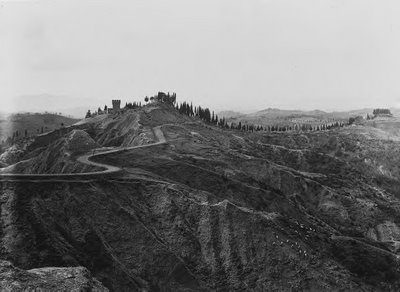
The Abbazia di Monte Oliveto Maggiore "the Abbey in the Clouds" is the mother house of the Olivetans, a congregation of Benedictine Monks founded in 1319 by Beato Bernardo Tolomei di Siena, a Siennese nobleman, on the eroded Cliff area to the south of Siena ("the crete").
With Bernardo Giovanni Tolomei were Patrizio Patrizi and Ambrogio Piccolomini, who decided to give up their wealth and privileges in favour of living according to the rule of St Benedict.
Construction began on the monastery in 1393 and was not completed until 1526, although a number of alterations were carried out on the buildings during the Renaissance and the Baroque periods.
The abbey itself is preceded by an imposing square tower that was part of the original defences erected to protect the entire complex.
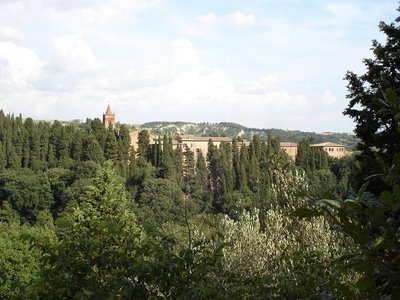
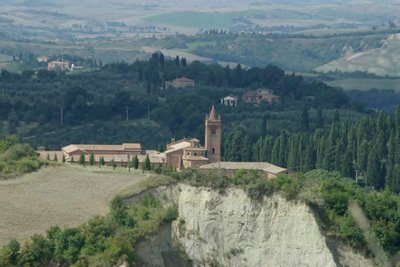
The courtyard of the abbey opens onto a broad avenue of cypresses.
A little further on is the fish pond designed in 1553 by Pelori and used by the monks to provide fish at those times of year during which the Benedictine rule forbade the consumption of meat.
The cypress avenue leads to the impressively austere, late-gothic church of the abbey, built between 1399 and 1417 by order of the Abbot Ippolito di Giacomo da Milano. The single nave interior has a cross plan. The fine carved wooden lector is by Raffaele da Brescia and the inlaid wooden choir stalls are by Fra’ Giovanni da Verona.
The transept leads to the Chapel of the Sacrament, whose altar is adorned by an early 14th century wooden Crucifix. In 1772 the church was redecorated in the late-Baroque style by Giovanni Antinori.
The abbey boasts three 15th century cloisters, of which the most magnificent is the rectangular Chiostro Grande, constructed between 1426 and 1443. It is made up of two walkways one above the other, supported by columns. The portico is decorated with a fresco cycle depicting the life of St Benedict by Luca Signorelli, who began work on its 36 large scenes in 1497. The cycle was finished in 1508 by Sodoma. The Chiostro Centrale is composed of a portico that rests on polygonal columns that lead to the magnificent Refectory, decorated with frescoes by Fra’ Paolo Novelli.
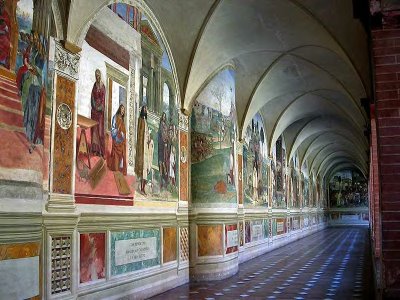
Chiostro Grande
St Benedict instructs the Shepherds by Luca Signorelli

From the Life of St Benedict by Il Sodoma
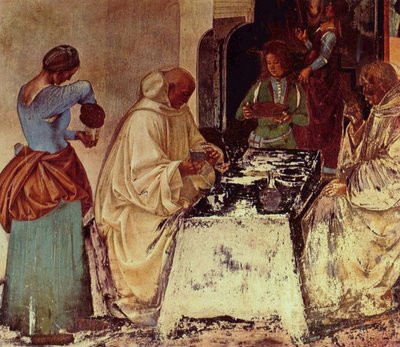
Part of the Fresco Cycle by Luca Signorelli
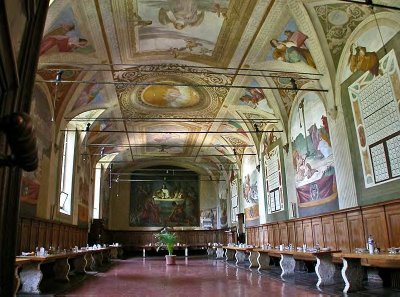 The Refectory
The RefectoryThe abbey’s large Library comprises no less than 40,000 volumes, pamphlets and parchments that are carefully restored by the monks.
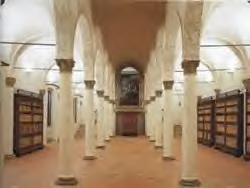
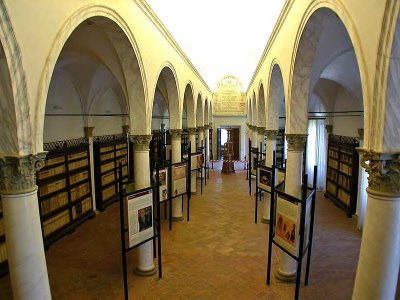
The Library
The Library leads to the Pharmacy, which contains an important collection of 18th century spice vases. The abbey still produces honey and distilled herbal spirits made according to these ancient recipes.
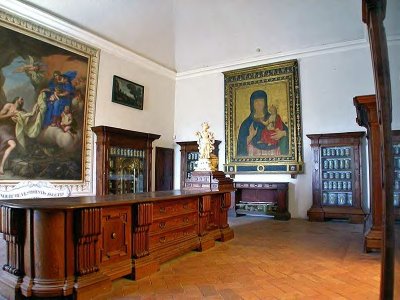
The Pharmacy
The correct name for the monks of the Abbey of Monte Oliveto, who are part of a number of congregations that make up the Benedictine order, is in fact Monaci Benedettini di Santa Maria di Monte Oliveto. Their particular devotion to the Virgin Mary is visible also in their habit, which is white to symbolise purity.
Many visitors come to the Abbey of Monte Oliveto to hear the Gregorian chants still sung by the monks.
The abbey web sites are at:
http://www.monteolivetomaggiore.it/
http://www.abbazie.com/mom/cg01_it.html
An article from The Tablet by an Olivetan monk: http://www.wccm.org/item.asp?recordid=frequent1&pagestyle=default :"Monte Oliveto" The Tablet August 10, 2004 by Laurence Freeman.
Laurence Freeman is a monk of the Olivetan Congregation and Director of The World Community for Christian Meditation (www.wccm.org).







 The Refectory
The Refectory



No comments:
Post a Comment